#Microvenator
Explore tagged Tumblr posts
Text
#Paleostream 22/03/2025
here's today's #Paleostream sketches!!!
today we sketched Sauroposeidon, Thescelosaurus, Vespersaurus, and Knoetschkesuchus




#Paleostream#paleoart#digital art#paleontology#digital artwork#artists on tumblr#palaeoart#digital illustration#sciart#id in alt text#dinosaur#sketch#sketches#paleoblr#palaeoblr#sauropod#Sauroposeidon#oviraptorosaur#Microvenator#ornithischian#Thescelosaurus#theropod#noasaurid#Vespersaurus#pterosaur#tapejarid#Torukjara#croc#eusuchian#Knoetschkesuchus
240 notes
·
View notes
Text
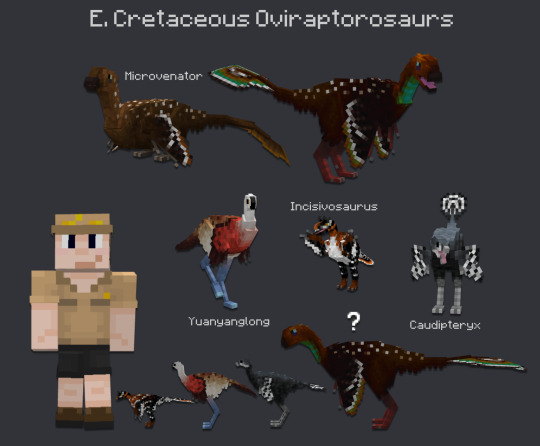
Though the majority of oviraptorosaur diversity existed later in the Cretaceous, several more primitive genera are known from the Early Cretaceous. I have created four to join our roster for this epoch, illustrating the morphological diversity of these initial forms.
An iconic dinosaur, well-known for its cartoonish front teeth, Incisivosaurus bears little resemblance to later oviraptorosaurs. The skull is elongate, crestless, and evidently toothed, in contrast to the more typical members of this clade. Incisivosaurus is among the most basal oviraptorosaurs and was important in illustrating that many of the group’s most bird-like features were the result of convergence. This animal was quite small and is known from a single 10 cm skull along with two referred juvenile specimens. It was likely a close relative of Protarchaeopteryx, with some researchers suggesting synonymy between the two genera. However, due to the crushed nature of the Protarchaeopteryx skull and the lack of an adult postcranial skeleton of Incisivosaurus, comparison remains difficult. Incisivosaurus possessed feathers, with the juvenile specimens exhibiting large tail fans similar to those known from its more derived relative, Caudipteryx.
Caudipteryx is another small oviraptorosaur, best known for its immaculate preservation which helped to establish the presence of feathers in non-avian dinosaurs. Fossilized melanosomes suggest that Caudipteryx was a dark colored animal with striping in the wings and tail fan. It bears more resemblance to later, more derived Oviraptorosaurs than to Incisivosaurus, with reduced teeth, a shortened skull, and more bird-like proportions. However, these dinosaurs were contemporaries and were both discovered in China’s Yixian Formation.
Yuanyanglong is a newly described dinosaur published in 2024. It had a comically small head and long legs. Ecologically, it may have been a wader. Two specimens are known, having been unearthed from the Miaogou Formation of northern China. While many Late Cretaceous oviraptorosaurs are described from localities in the Gobi desert, this is the first known from the Early Cretaceous in that region. The species name “bainian” means "a hundred years,” and honors the 100th anniversary of the naming of Chirostenotes and Oviraptor, both described in 1924.
Finally, Microvenator is a quite speculative inclusion. Known from only a single juvenile specimen, the identity of this animal remains uncertain. It was initially interpreted as a small predatory dinosaur, with Deinonychus teeth being attributed to it. Later study established that it was, in fact, an oviraptorosaur, the oldest known from North America. However, whether it is a primitive oviraptorosaur along the lines of Incisivosaurus, or a more derived oviraptorosaur remains uncertain. Recent phylogenies tend to find that it is the most basal Caenagnathid, meaning that it is more closely related to Anzu than to Oviraptor, and as such, quite derived. Thus, the appearance, as interpreted here, is more like the oviraptorosaurs of the Late Cretaceous than the more basal relatives otherwise known from the Early Cretaceous.
60 notes
·
View notes
Text
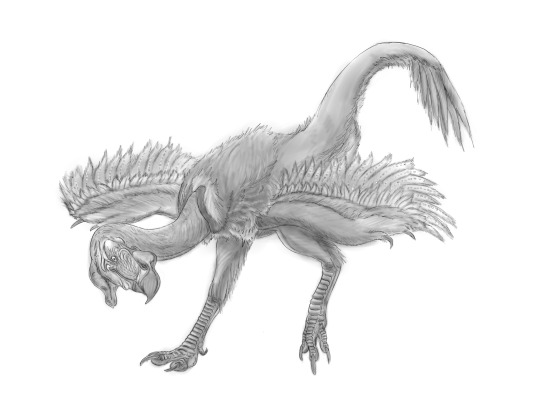
Cockatrice (Artwork by Yuujinner)
Kingdom: Animalia
Phylum: Chordata
Class/Clade: Reptilia (Sauropsida)
Clade: Diapsida
Clade: Archosauria
Clade: Dinosauria
Clade: Saurischia
Clade: Eusaurischia
Clade: Theropoda
Clade: Neotheropoda
Clade: Averostra
Clade: Tetanurae
Clade: Avetheropoda
Clade: Coelurosaria
Clade: Maniraptoriformes
Clade: Maniraptora
Clade: Pennaraptora
Clade: Oviraptorosauria
Clade: Edentoraptora
Superfamily: Caenagnathoidea
Family: Caenagnathidae?
Subfamily: incertae sedis
Genus: Ornithosaurus
Species: O. necrophilus (“death-loving bird lizard”)
Ancestral species: possibly Microvenator celer
Temporal range: late Pleistocene to recent (87,000 kya - present)
Information:
A ravenous scavenger, the cockatrice is by no means at the top of its food chain, though its uniquely offensive, musky odor, ear-splitting vocalizations, and proclivity for traveling in large groups called flocks make it a creature which few predators wish to tolerate. Add onto this its territorial aggression, and you have what may be Archaeonesia’s most detested scavenger. Cockatrices use their superb sense of smell to detect carrion from several tens of miles away, primarily feeding on the carcasses of various reptilian and mammalian megafauna, sometimes flocking around fresh kills made by larger predators and using their sheer number to overwhelm the carnivore into relinquishing its kill. Though it usually eats carrion, it is also classified as an opportunistic feeder, readily going after small vertebrates. Found primarily in the Arava Desert and the surrounding grasslands in the western half of the Isle of Perils, this medium-sized oviraptorosaur is known all throughout the Isle of Perils, including its central mountain range, making it one of the few non-avian dinosaurs to live in that region. It is also one of the few non-avian dinosaurs to actively seek out human settlements, particularly to feed on discarded scraps of food. Actively seeking out human settlements, it is known to scavenge from trash heaps and refuse bins, which make it a local pest in some areas. Entire flocks of these animals, as many as 40 individuals sometimes, may swarm landfills. Similarly, these creatures will use their sheer number of overwhelm larger carnivores into relinquishing kills before greedily tearing into their spoils. A pecking order can be observed amongst these animals, typically in which the largest male gets first pickings on the corpse. When feeding on carrion, as gruesome as it may be, they will typically eat away at the orifices first before hollowing out the cadaver. Due to its exceptionally strong stomach acids being able to kill most bacteria, it can eat carrion which most other scavengers would otherwise find too putrid or dangerous to consume. Attracted to shiny objects for the purposes of adorning their nests with them, they have been known to steal jewelry, though those which live farther from human settlements may instead use quartz and other naturally occurring crystals to adorn their nests. These animals are exceptional jumpers, being able to clear fences nearly 12 feet all and jump nearly 25 feet in a single bound. Exceptionally territorial in nature, groups may mark trees and rocks with a pair of scent glands behind their ears, which produce the foul musky odor typically associated with the animal. As these animals are quite social, their ability to recognize patterns (and more specifically faint color patterns and facial differences) allow them to differentiate between one another with remarkable ease. They can also recognize human faces with exceptional accuracy. Grooming behavior is well-documented, and like primates, it plays an important role in establishing social relations. Primarily diurnal, these animals rely on scent and eyesight to find food, and typically, a few individuals will venture away from the nesting grounds at a given time to locate food before they’ll go back and alert the others of its location, utilizing what is sometimes described as an elaborate“dance”, consisting of many different vocalizations, as well as head and body movements, to communicate location, much in the same way honeybees do. As the many environments it lives in are teeming with predators, a few individuals will take shifts throughout the night to watch the nesting grounds while the others sleep. A pouch at the base of the neck, commonly called a crop, allows the animal to store food before digesting it, though it serves a dual function of allowing it to transport food back to the nest to feed its offspring.
Though a given flock of cockatrices may not necessarily consist of entirely closely related individuals, it is more common than not for a flock to consist of a set of parents or grandparents and several generations of offspring. During the beginning of the dry season, around early December, the males’ colors will become substantially more flashy and eye-catching, his wattle flushing a bright maroon and violet color and the undersides of his wings flushing a pink hue, and although related species are known to engage in mock fights as part of mating displays, this species instead relies on a less violent method of winning approval from the females they wish to court: designing the most colorful display. A male will create a nest and adorn it with the most colorful materials he can found, anything from flowers and fruits to rocks and crystals. However, this is only part of the courtship ritual. While a bright nest may earn some initial interest from female suitors, it is what he does next that determines his success: performing an elaborate dance, sometimes with a shiny rock clutched in his beak, he will angle his head up towards the sky, revealing his brightly-colored wattle and wings. High-stepping in a circle around her, his throat will undulate to make a deep, rattling bellow, beating his wings and jumping up and down to keep her attention. If she accepts, she will join him in this dance and copulation begins. Cockatrices mate for life, and in 1.5 months time, she will lay a clutch of 2-4 blue eggs in the nest, and for the 5 weeks it will take for them to hatch, she will not leave the nest, the male fetching her food and water via his crop. When the young are born, they are, in a rare exception amongst non-avian theropods, altricial, being born nearly featherless and unable to walk for the first few weeks of life. By a month old, they will be able to walk. By a year, they will have reached half their adult size, being large enough to join their parents in the search for food. By 2 years, they will reach adult size, and at around 3.5 years, they will have gained their adult plumage and will reach sexual maturity. Many may choose to stay with their parents’ flock, though some may go off and form flocks with other young cockatrices. If they’re lucky, a cockatrice may expect to live 20-30 years.
Around the size of a cassowary, this species is around 5.6 feet tall, roughly 9-10 feet in length, and weighs around 200 lbs on the heavier side. There is no notable sexual dimorphism between species. The naked head is highly fluorescent, the neck being reddish yellow and the wattle/fleshy growths on its face being yellowish-orange and bluish-purple. The beak is red and the eyes are white. Plumage is white on the body and most of the wings, though near the base of the neck, the tail, and the wing feathers, the plumage starts to turn black, with the wing plumage having many beige spots along their length. Its legs are yellowish-gray.
Long-renowned for its dissonant calls, this species generally communicates with others of its kind with rasps, shrill humming, and a sound variously called “bleating” or “bugling”. Territorial calls consist of loud, deep booms which rumble across the land. However, it may hiss or honk if aggravated or in an attempt to intimidate and size up other scavengers/carnivores, and it has a characteristic shrieking whoop referred to by some as a “dinner bell call” to other cockatrices that food has been located.
Much in the same way that vultures are viewed as unclean and malevolent animals in Western society, so, too, is the cockatrice in Xenogaean society, made dually ironic for the fact that vultures also exist in the region, albeit typically in more montane environments. Long seen as a bad luck omen, stumbling across a dead cockatrice was said to signal impending disaster, particularly famine or drought, and in fact, it was said that if one did stumble across one, or managed to kill one, they were to immediately cremate it and spread its ashes in a river. Nonetheless, it does appear in some heraldic imagery and was venerated amongst some indigenous peoples in the region, particularly to the southeast. It was said the Bronze Age Aravan King, Kuntapurexa, infamous for his brutal conquests across the Isle of Perils, was followed by a horde of cockatrices which reaped the benefits of his conquests, feeding on the corpses of those he and his men killed as they went from village to village pillaging and marauding. The deafening sounds of these animals from afar was therefore used by some villagers as a way to determine how close Kuntapurexa and his men were to their settlement and therefore whether or not to abandon the town. How true this was, however, remains up to speculation, as no surviving historical records seem to confirm if this was a true account or not, with the possibility of it being a tall tale being rather likely. That said, if one can get past the animal’s revolting smell and dietary habits, a tame cockatrice makes for an exceptional companion animal, being exceptional at navigating, tracking, and retrieving items and trinkets, and in times past, some would use these animals to discretely transmit messages across long distances in a similar manner to messenger pigeons. On top of that, its affectionate nature towards those it’s acquainted with makes it decent as a pet as well, minus its food requirements. In fact, while some cities actively try to exterminate or otherwise relocate cockatrices within their walls, others may actively promote breeding programs for the animals in an effort to reduce waste in landfills. Despite being classified as a caenagnathid oviraptorosaurian, this placement is tentative: though its skull anatomy and genetic data would seem to support an inclusion amongst the Caenagnathidae or at least closer to the Caenagnathidae than the Oviraptoridae, the anatomy of its arms (and its wrists in particular) is exceptionally basal, more akin to that of therizinosaurs or ornithomimosaurs than to that of other oviraptorosaurs. Amongst an indigenous group in the Arava Desert region known as the Nge'echets, the cockatrice was seen as an embodiment of the desert itself, almost a god in its own right, far contrary to how their Xenogaean-speaking neighbors viewed the animal. As such, offerings were left out to the animals as a way of asking for safe passage from one oasis to the next as part of their migratory lifestyle. Nonetheless, amongst all native cultures in the region, the consumption of this animal’s meat is considered taboo due to its scavenging lifestyle. In lieu with its scavenging lifestyle, flocks of these animals may follow sick or injured animals for miles, waiting for them to collapse before finishing them off, hence it was long said that spotting a cockatrice behind oneself was a sign that death was on one’s doorstep. In some regions, they are also associated with the Xenogaean death goddess, Yerakiya, seen as either her messengers or even as a form she herself takes in the world of the living. Bones of this animal date back to the late Pleistocene, around 87,000 years ago, and fossil member of the genus are known as far back as the Miocene. A smaller closely-related species found on an offshore island, the basilisk (O. insularis), went extinct in the 18th century due to the introduction of pigs by British colonists. With around 2,000,000 mature adults in the wild, populations appear to be stable but declining in certain areas.
#scifi#fantasy#speculative evolution#novella#scififantasy#speculative biology#speculative fiction#speculative zoology#worldbuilding#creature art#oviraptorosauria#cockatrice#sci fi#scifi worldbuilding#fantasy worldbuilding#fantasy creature#scifi creature#dinosaurs#dinosaur#spec evo
15 notes
·
View notes
Text
Microvenator celer
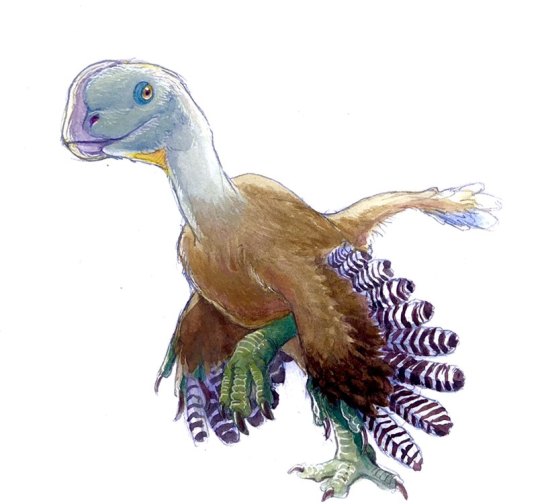
By Ripley Cook
Etymology: Small Hunter
First Described By: Ostrom, 1970
Classification: Dinosauromorpha, Dinosauriformes, Dracohors, Dinosauria, Saurischia, Eusaurischia, Theropoda, Neotheropoda, Averostra, Tetanurae, Orionides, Avetheropoda, Coelurosauria, Tyrannoraptora, Maniraptoromorpha, Maniraptoriformes, Maniraptora, Pennaraptora, Oviraptorosauria, Caenagnathoidea, Caenagnathidae
Status: Extinct
Time and Place: Between 115 and 105 million years ago, from the Aptian to the Albian ages of the Early Cretaceous

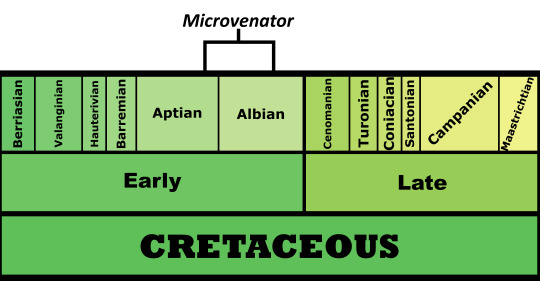
Microvenator is known from the Cloverly Formation of Montana and Wyoming; specifically the Little Sheep and Himes members of the Formation
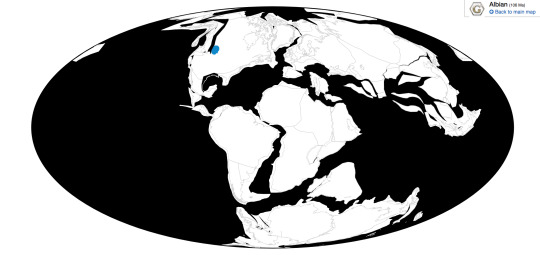
Physical Description: Microvenator was an Oviraptorosaur - aka, a Chickenparrot - one closely related to the later Anzu from the Hell Creek formation at the end of the Cretaceous. Still, the main remains it is known from are a juvenile, which actually lead to its name - prior to further study, we thought the juvenile was as big as it got, and thus named it for its small size. As such, Microvenator probably got much bigger than the original estimates - while the juvenile was about 1.2 meters long, an adult would probably be around 3 meters long.
As a chickenparrot, Microvenator would have been fairly squat in body, and it had a shorter tail than your average dinosaur - but, as an earlier member of the group, it didn’t have a pygostyle like some of the later species. It had long arms and moderate length legs, and was covered in feathers - especially notable wings on the arms and a tail fan on the tail. It probably had a large beak, as well, but little of the skull is known.
Diet: As an Oviraptorosaur, Microvenator probably had an omnivorous diet, eating a wide variety of food, especially plants.
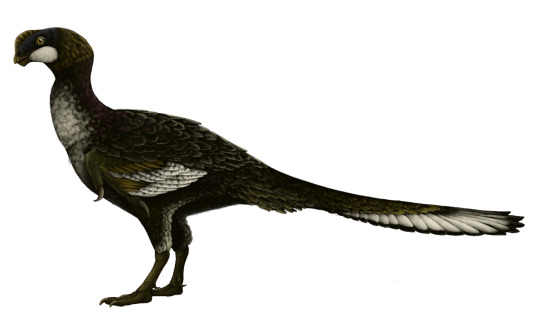
By Scott Reid
Behavior: Though Microvenator isn’t particularly well-known, it probably behaved similarly to its close relatives, including in taking care of its young. Oviraptorosaurs are known to have been great parents, creating large nests with eggs laid around the edge, laid from a single oviduct. Microvenator would have then sat in the center of the nest, and used its wings to keep the eggs warm - much like how birds do so today. Microvenator laid ovular, elongated eggs, which were probably turquoise or teal in color.
Microvenator was a feathered, warm-blooded animal, and thus very active in its environment and with its behavior; using its feathers to display to other members of the species for sex and communication - and its large wings and tail fan would have been excellent for these activities. As an omnivore, it would have been an opportunistic animal as it looked around its environment for food.
Ecosystem: The Cloverly Formation was one of many distinctive “middle” Cretaceous environments in Western North America, a transition between the iconic Late Jurassic and Late Cretaceous faunas of the area. Here, the Western Interior Seaway was growing in Microvenator’s backyard, which was mainly a floodplain and river system with extensive flooding that buried many animals at a time. These plains were forested, covered with many conifers and cycads.
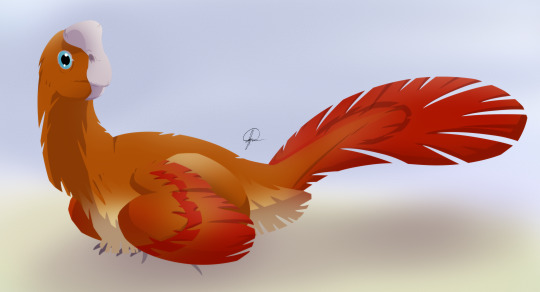
By José Carlos Cortés
The earlier environment, the Little Sheep ecosystem, was much muddier and less associated with the sea than later times. Here, Microvenator lived with the ankylosaur Sauropelta, the ornithopod Tenontosaurus, the small fast-moving herbivore Zephyrosaurus, and the medium-sized theropod Deinonychus. There was an unnamed sauropod as well, as well as lungfish, sharks, fish, frogs, salamanders, crocodilians, and turtles - and a lot of types of mammals and lizards, which would have been decent food for Microvenator in a pinch.
The later Himes ecosystem was sandier, and more associated with the sea as it grew into North America. Microvenator still lived alongside Deinonychus, Sauropelta, and Tenontosaurus, but also the large sauropod Sauroposeidon and the poorly known Rugocaudai; a new nodosaur, Tatankacephalus, and the large predator Acrocanthosaurus which would have been a major threat to Microvenator. There also may have been a proto-bird present in the ecosystem, along with many kinds of lizards, frogs, salamanders, crocodilians, turtles, fish, sharks, and mammals.
Other: Microvenator is the oldest known Oviraptorosaur from North America!
~ By Meig Dickson
Sources under the Cut
Mackovicky, Peter J., Sues, Hans-Dieter. (1998). "Anatomy and phylogenetic relationships of the Theropod Dinosaur Microvenator celer from the Lower Cretaceous of Montana” American Museum Novitates. Number 3240, 27pp. 27 August 1998.
Maxwell, W. D. 1993. Neonate dinosaur remains and dinosaur eggshell from the Lower Cretaceous Cloverly Formation, Montana. Journal of Vertebrate Paleontology 13(3, suppl.):49A
Norell, M.A., Gaffney, E.S., and Dingus, L. 1995. Discovering Dinosaurs in the American Museum of Natural History. Alfred A. Knopf, Inc.:New York, 204 p.
Oreska, M. P. J., M. T. Carrano, and K. M. Dzikiewicz. 2013. Vertebrate paleontology of the Cloverly Formation (Lower Cretaceous), I: faunal composition, biogeographic relationships, and sampling. Journal of Vertebrate Paleontology 33(2):264-292 [
Ostrom, J. H. 1970. Stratigraphy and paleontology of the Cloverly Formation (Lower Cretaceous) of the Bighorn Basin area, Wyoming and Montana. Peabody Museum Bulletin 35:1-234
Sato, T., Y. Cheng, X. Wu, D. K. Zelenitsky, Y. Hsaiao. 2005. A pair of shelled eggs inside a female dinosaur. Science 308 (5720): 375.
Varricchio, D. J. 2001. Late Cretaceous oviraptorosaur (Theropoda) dinosaurs from Montana. pp. 42–57 in D. H. Tanke and K. Carpenter (eds.), Mesozoic Vertebrate Life. Indiana University Press, Indianapolis, Indiana.
Wiemann, J., T.-R. Yang, P. N. Sander, M. Schneider, M. Engeser, S. Kath-Schorr, C. E. Müller, P. M. Sander. 2017. Dinosaur origin of egg color: oviraptors laid blue-green eggs. PeerJ 5: e3706.
#Microvenator#Microvenator celer#Dinosaur#Oviraptorosaur#Bird#Birds#Dinosaurs#Terrestrial Tuesday#Palaeoblr#Birblr#Feathered Dinosaurs#Prehistoric life#Paleontology#Prehistory#Omnivore#North America#Cretaceous#Factfile#biology#a dinosaur a day#a-dinosaur-a-day#dinosaur of the day#dinosaur-of-the-day#science#nature
183 notes
·
View notes
Text
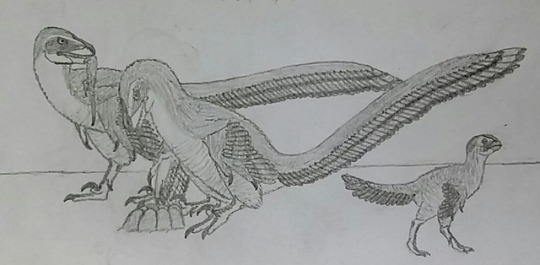
Deinonychus couple guarding their nest while Microvenator passing on.
65 notes
·
View notes
Text
Samsung microwave Oven repair
Samsung microwave Oven repair is one of the leading brands in India. Which we provide the best products to the users which contain quality. This Godrej provides the most important home appliances to the customer’s microwave ovens. These are the major products which we use in our daily life and this product became one of the parts in our daily life. These microwave ovens can also be known as electrical ovens that will provide electromagnetic waves which are known as microwaves so are known as microwave ovens. The usages of these products are very high. These home machines will assume a significant part in each home for our service, we have numerous normal clients. We are the best services to the customers.

0 notes
Text
Microvenator
El Microvenator era un pequeño dinosaurio que vivió durante el cretáceo temprano hace entre 113 y 119 millones de años. Fue un terópodo avanzado que vivió en lo que hoy es Montana,EE.UU.
APARIENCIA
El nombre Microvenator Significa pequeño Cazador. Se trataba de terópodos de confección ligera que crecían hasta alrededor de un metro de largo y pesaban entre 3 y 5 kg. Probablemente eran como del tamaño de un pavo. Tenían los brazos cortos, ojos grandes, el cuello largo, una cabeza pequeña y un hocico largo.
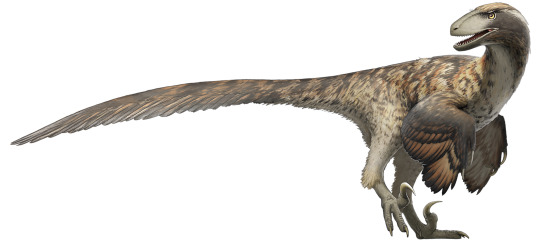
Un dinosaurio inteligente
En comparación con el tamaño de su cuerpo el Microbenator tenía un cerebro grande. Esto hace pensar que debe haber sido uno de los dinosaurios más inteligentes.
Dedos y garras
El microbenator tenia largos dedos en cada mano cada dedo terminaba en una garra afilada. También tenía tres dedos con garras en cada pie probablemente las utilizaba para matar a sus presas.
Corredores bípedos
El microbiato era un dinosaurio bípedo. Caminaba sobre dos piernas largas y delgadas como de pájaro debe haber sido un corredor rápido.
Hallazgos fósiles
Los primeros fósiles de Microsoft los encontraron barnum brown en Montana,EE.UU. en 1933 .Brown había incluido dientes de Deinonychus con los fósiles que encontró y pensó que había descubierto un animal nuevo con un cuerpo pequeño y una cabeza inusualmente grande. Sin embargo en 1970 John ostram lo clasificó correctamente y lo llamó microavenator.
¿Sabías que?
Cuando el microbenator vivía la tierra era un lugar mucho más cálido. las plantas no estaban cubiertas con capas de hielo

2 notes
·
View notes
Text
This is a really long shot, but I need all the help I can get on this. I'm working on a huge prehistoric creature research project/ video game, and I want to include as many prehistoric creatures from the American Museum of Natural History as I can (partially because it's my favorite museum). If you see this and remember any prehistoric creatures (besides types of man ie Homo Sapiens, Homo Neandertalis, Homo Erectus, Australopitchicus, etc sorry if I butchered one or two of those, I havent written them in a while), could you please comment or reblog with as many that arent on my list as you can? I'd really appreciate it. Hres the list
T-Rex, Stegosaurus, Barosaurus, Coelocanth, Mastodon, Wooly Mammoth, Mastodonosaurus, Apatodaurus, Hybodus, Allosaurus, Titanosaur (aka Patagotitan), Trilobite, Camarasaurus, Pteranodon, Megalodon, Dunkleosteus, Tylosaurus, Oviraptor, Edmontosaurus (Mummified), Protoceratops, Pachycephalosaurus, Smilodon, Indricotherium, Edaphosaurus, Dimetrodon, Archaeopteryx, Coelophysis, Prestosuchus, Plesiadapis
Thank you again
EDIT - I have found more prehistoric creatures, but i know this isnt all of them
Struthiomimus, Styracosaurus, Tenontosaurus, Saurornithordes, Psittacosaurus, Sauropelta, Saurolophus, Prosaurolophus, Ankylosaurus, Microvenator, Hypacrosaurus, Albertosaurus, Argentinosaurus, Centrosaurus, Chasmosaurus, Deinonychus, Edmontonia, Hesperornis, Panocthus, Scutosaurus, Lambeosaurus, Corythosaurus, Psilopterus, Presbyornis, Plateosaurus, Camptosaurus, Parasaurolophus, Eryops, Trimerorhachis, Archelon, Moschops, Diplodocus, Mamenchisaurus, Ornitholestes, Triceratops, Stenopterygius, Ceratosaurus, Velociraptor
1 note
·
View note
Text
Luxury Microwave Oven for Cooking and Baking

This is a pro series combination or Microwave oven. This microven is help you to cooking, baking needs in the kitchen. In this product you find extra large capacity you can bake on three levels simultaneously. Type:- Type: Solo micro
Installation: Built-in
Size (cm): 45 cm
Display: TFT colour display 6.1 inches Linear Concept™ display
Colour: Black steel
Capacity: 50 litre
Product Url:- https://hafeleappliances.com/luxury-appliances/cooking-and-baking/microwave-oven/om8487b
0 notes
Text
I keep that in an undisclosed location, which is definitely not inside my microven
i have lots of bones, they are mine :)
45 notes
·
View notes
Text
software de gestion comercial
software upv Un factor clave para la competitividad de una compañía es su diferencia con las otras, su personalidad. Para la resolución de cualquier tipo de polémica, pleito discrepancia que pudiera provocarse entre el usuario y NEOSYSTEMS por el empleo de este sitio, recuerda el sometimiento de las mismas a los Juzgados y Tribunales de la urbe de Oviedo, Asturias, España. Aplicaciones Windows desarrolladas usando los más modernos componentes, lo que ofrece interfaces de uso muy afables. Es decir, efectuamos el ciclo completo de un desarrollo de software. Bosstel es una compañía de telefonía móvil que ofrece servicios de liberación de teléfonos,... Se prohíbe la modificación, copia, reproducción, descarga, transmisión, distribución transformación de los contenidos del Portal, si no se tiene la autorización del titular de los pertinentes derechos no se halla legalmente permitido. Si comprendemos como estándar el que se amolda a las generalidades comunes de cualquier compañía, el desarrollo de software a medida se amolda a las especificaciones y necesidades específicas de cualquier empresa. http://www.youtube.com/watch?v=Y05vv5tEfss de cualquiera de nuestras soluciones, uno de nuestros especialistas se va a poner en contacto con usted para ofrecerle, a través de internet, una demostración adaptada. http://www.youtube.com/watch?v=3X4RWI0XsSg : Espacio Tecnológico Molinón, Estadio El Molinón 100, C.P. treinta y tres mil doscientos tres Gijón (Asturias). La mayoría de los programas de software personalizados tienen la capacidad de solucionar eficientemente y simplificar inconvenientes puntuales y la sistematización ayuda a reducir el gasto en las compañías. El mero acceso no implica el establecimiento de ningún género de relación comercial entre NEOSYSTEMS y el usuario. En cumplimiento con lo dispuesto en la Ley Orgánica 15/1999, de trece de diciembre, de Protección de Datos de Carácter Personal (LOPD), NEOSYSTEMS notifica a los usuarios del presente sitio web que los datos personales facilitados a través de exactamente el mismo, van a pasar a formar parte de un archivo de datos de carácter personal, cuya titularidad y responsabilidad corresponde a NEO INGENIERÍA INFORMÁTICA SL, siendo su finalidad sostener un canal de comunicación entre el usuario y la entidad para dar contestación a las cuestiones planteadas, como poder informarle y trasmitirle información sobre los servicios prestados por NEOSYSTEMS. En cumplimiento de la LOPD 15/99, le notificamos de que la cumplimentación del presente formulario implica el expreso consentimiento a que los datos personales facilitados del interesado sean incorporados y tratados en ficheros automatizados, cuyo responsable es MICROVEN, S.A.L. con el objetivo de administrar la relación comercial con sus clientes del servicio. El usuario accede voluntariamente a este sitio. Los contenidos y servicios incluidos y ofrecidos en este sitio web no están dirigidos a aquellas personas residentes en aquellas jurisdicciones donde no se encuentren autorizados. Se adapta a las necesidades específicas de la empresa.
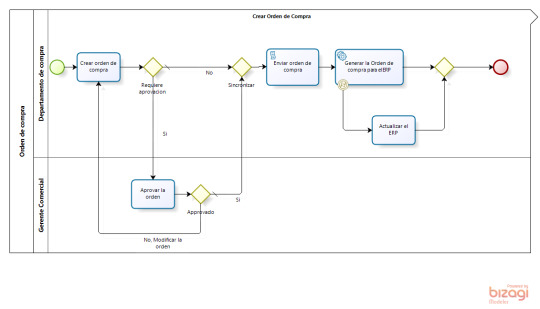
0 notes
Text
kitchen appliances online - SATHYA
Some fruit in a nice juicer and freshly ground powder in a fruit mixer takes care of your morning beverage and kitchen appliances list with price are available with Sathya online appliances with best kitchen appliances offers. To follow it up with a healthy breakfast, we have a range of whole kitchen set, mixer, grinder, microven, cooker, dishwasher, stove, chimney that help to make your kitchen more beautiful and that will let you place together a meal in a snap. Lunch for the family is only a matter of minutes, with a slight help from our hot plates, microwave ovens, rice cookers, induction cookers, grinders and food processors. An detailed dinner plan for the weekend is comfortable when our tandoors and barbeques let you grill meat and veggies like a seasoned chef which you get with Sathya online shopping kitchen appliances. Visit us: www.sathya.inCONTACT NO :7339400400
0 notes
Text
Who is flashiest tailed birb group??? vote now on phones!!!
#palaeoblr#dinosaurs#poll#raptors#birds#I know dromaeosaurs will probably win but I can dream and hope right?#chickenparrots#anzu#velociraptor#stenonychosaurus#anchiornis#archaeopteryx#confuciusornis#yi
99 notes
·
View notes
Text
60% off code - microven
60% off code – microven
Product Details 55lbs Full Motion TV Wall Mount Bracket
Features: 1. Ultra-slim design, slimmest mounting solution 2. Brand new and high quality 3. It can let the TV be positioned stably 4. Help you to save a lot of space, letting your home look more tidy and roomy 5. It is easy and convenient to install, you just need to place the TV on the desk 6. Made of durable material, can be used for a…
View On WordPress
0 notes
Photo

Samsung microwave Oven repair
Samsung microwave Oven repair is a convection oven that makes use of a fan that pushes air movement and heats up the inside of the oven so the food is cooked from inside first and then outside. This is why convection ovens help you bake and roast foods that you would otherwise need a lot of time to cook. It is an electromagnetic wavelength device with radiation. When we put more oil and fatty items will absorb more water and release evaporation. The oven has time minutes to cook any item to do. A micro oven cooks 20% faster than cooking by hand, it is kitchen room appliances. It must be fixed in one place and don’t move it from one place to another place.
0 notes
Video
All Smiles by Microvenator
0 notes